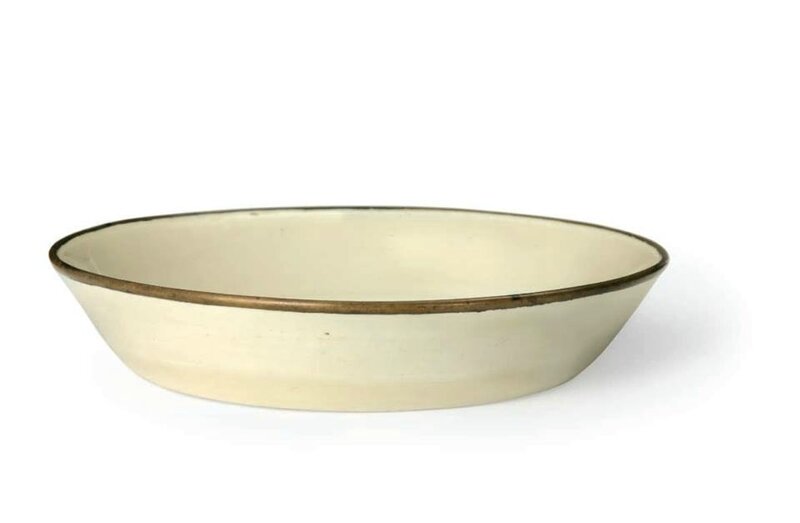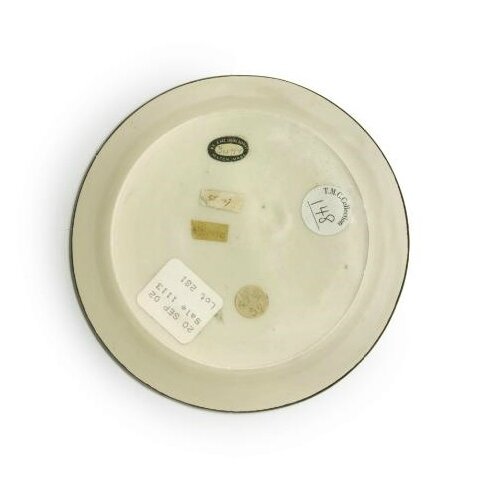Christie's. The Classic Age of Chinese Ceramics - The Linyushanren Collection, Part III, 22 March 2018, New York
A rare carved Ding 'Chilong' brush washer, Northern Song dynasty, 11th-12th century
Lot 505. A rare carved Ding 'Chilong' brush washer, Northern Song dynasty, 11th-12th century; 5 ½ in. (14 cm.) diam. Estimate USD 60,000 - USD 80,000. Price realised USD 468,500. © Christie's Images Ltd 2018
The brush washer is finely potted with gently rounded, shallow sides rising to an unglazed rim mounted with a copper band. The interior is fluently carved with a coiled chilong, and the washer is covered inside and out with a glaze of creamy ivory color which pools slightly to a darker shade in the recesses and above the foot, and continues over the flat base, cloth box.
Provenance: Mr. and Mrs. Eugene Bernat Collection.
Sotheby Parke Bernet New York, 7 November 1980, lot 113..
Literature: Museum of Fine Arts, Boston, Exhibition of the Chinese Ceramics Lent by Mr. and Mrs. Eugene Bernat, 1947, no. 71.
The Currier Gallery of Art, Chinese Ceramics of the Sung Dynasty, Manchester, New Hampshire, 1959, no. 11.
Smith College Museum, Chinese Art. An Exhibition of Paintings, Jades, Bronzes and Ceramics, Northampton, Massachusetts, 1962, no. 114.
Sir Harry Garner and Margaret Medley, Chinese Art, vol. III, London, 1969, p. 128, reel 17, no. 6.
Christie's, The Classic Age of Chinese Ceramics: An Exhibition of Song Treasures from the Linyushanren Collection, Hong Kong, 2012, pp. 30-31, no. 5.
The present brush washer as illustrated in the Currier Gallery of Art, Chinese Ceramics of the Sung Dynasty, Manchester, New Hampshire, 1959, no. 11.
Exhibited: Museum of Fine Arts, Boston, Exhibition of the Chinese Ceramics Lent by Mr. and Mrs. Eugene Bernat, 9 September to 19 October 1947.
The Currier Gallery of Art, Chinese Ceramics of the Sung Dynasty, Manchester, New Hampshire, 11 April to 31 May 1959.
Smith College Museum, Chinese Art. An Exhibition of Paintings, Jades, Bronzes and Ceramics, Northampton, Massachusetts, 1962.
On loan: Worcester Art Museum, Worcester, Massachusetts.
Christie's, The Classic Age of Chinese Ceramics: An Exhibition of Song Treasures from the Linyushanren Collection, Hong Kong, 22 to 27 November 2012; New York, 15 to 20 March 2013; London, 10 to 14 May 2013.
Note: Created at the Ding kilns in Hebei province, this exquisite brush washer represents the type of ceramic ware most preferred at the Imperial Court in the late eleventh and early twelfth century. Although its steeply canted side walls are undecorated inside and out, an auspicious chilong ??, or hornless dragon, embellishes the vessel’s wide floor.
An ancient mythological creature that appears in Chinese literature at least as early as the Warring States period (481–221 B.C.), the chilong is characteristically presented as a young, playful creature. Technically meaning “hornless dragon”, the term chilong is usually translated as “young dragon” or “baby dragon”, its lack of a horn generally accepted as meaning “immature” and thus young. When shown singly, as in this brush washer, it characteristically turns its head to look over its back and toward its tail, thus assuming a C-shape. In other instances, the chilong may be depicted together with one or two additional chilong, and occasionally in the company of a mature dragon, or long ?, the mature dragon typically identified as the mother; in such “family presentations”, the several chilonggenerally frolic around their mother, playing with each other and even scampering over their mother’s back.
Like its close relative, the mature long dragon, the chilong is an auspicious emblem that denotes high status and conveys to the viewer every good wish for success and prosperity. Moreover, the Lüshi Chunqiu ????—a text written around 239 B.C. by Lü Buwei ??? (290–235 B.C.) and whose title can be translated as Master Lü’s Spring and Autumn [Annals]—attributes to Confucius (551 B.C. – 479 B.C.) a quote in which he compares long ? “dragons”, chi ? “hornless dragons”, and yu ? “fish” and then likens himself to a hornless dragon ?: “Master Kong [i.e., Confucius] said, ‘The dragon eats and swims in clear water; the hornless dragon eats in clean water but swims in muddy water; fish eat and swim in muddy water. Now, I have not ascended to the level of a dragon, but nor have I descended to that of fish; perhaps I am a hornless dragon!’" (Quotation adapted from John Knoblock and Jeffrey K. Riegel, The Annals of Lü Buwei, Stanford, CA: Stanford University Press, 2000, p. 505.) This association of Confucius with the chilong assured that creature an elevated status in Chinese mythology as well as an honored place in the repertory of decorative-arts motifs.
Ding vessels with chilong décor may depict the creature singly, as in this brush washer, or paired with other chilong, as noted above. A single chilong may appear against an unembellished background, as witnessed here, or it might be surrounded by scrolling clouds or a lotus arabesque.
A carved Ding ‘chilong’ washer of similar form and decoration, but of slightly smaller size (12 cm. diam.), in the National Palace Museum, Taipei, is illustrated by Tsai Meifen, Decorated Porcelains of Dingzhou: White Ding Wares from the collection of the National Palace Museum, Taipei, 2014, p. 102, no. II-58. The present brush washer’s carved chilong is also close in style to that on the floor of a Northern Song Ding bowl illustrated by Jan Wirgin, Sung Ceramic Designs, London: Han-Shan Tang, 1979—originally published in The Museum of Far Eastern Antiquities Bulletin, no. 42, Stockholm, 1970—n.p., Pl 70b. A Ding dish sold at Christie’s New York, 18–19 September 2014, lot 732, exhibits a carved chilong that resembles the one on this vessel, though it is surrounded by a lotus scroll. A dish with steeply canted side walls and carved chilong-and-cloud décor on its floor is pictured in Guoli Gugong Bowuyuan [National Palace Museum], ed., Gugong Songzi Tulu / Illustrated Catalogue of Sung Dynasty Porcelain in the National Palace Museum, Dingyao – Dingyaoxing / Ding Ware and Ding-type Ware, Tokyo: Gakken, 1973 (bilingual, Chinese and English), np., Pl. 60. For a Ding dish of similar form but decorated with a pair of chilong, see Tsai Meifen, op. cit., no. II-59.
Like the celebrated Ding 'partridge-feather' conical bowl from the Linyushanren Collection also offered in this sale (lot 506), this brush washer once belonged to distinguished Boston collectors Eugene and Elva Bernat. Active in the mid-twentieth century, Mr. and Mrs. Bernat assembled a comprehensive collection of early Chinese ceramics numbering more than 150 pieces and ranging in date from the Neolithic period through the Song dynasty. Renowned for its Song wares, of which it included more than 100 examples, the Bernat collection claimed numerous masterpieces which were often featured in special exhibitions and illustrated in scholarly books. Eagerly sought by museums and private collectors alike, works from the famous Bernat Collection spread to all parts of the globe when it was dispersed at auction in November 1980.
Collectors of the Ming (1368–1644) and Qing (1644–1911) dynasties ranked Ding ware among the “five great wares of the Song”, along with Jun, Ru, Guan, and Ge wares. Celebrated for their porcellaneous white wares, the Ding kilns also produced pieces with russet and black glazes, such as the magnificent 'partridge-feather' conical bowl from the Linyushanren Collection also offered in this sale (lot 506). Although not imperial kilns per se—that is, they were not operated by the government and did not produce ceramics exclusively for the imperial household—the Ding kilns nevertheless supplied substantial quantities of ceramic ware to the palace in the late tenth, eleventh, and early twelfth centuries.

/https%3A%2F%2Fprofilepics.canalblog.com%2Fprofilepics%2F1%2F0%2F100183.jpg)
/https%3A%2F%2Fstorage.canalblog.com%2F03%2F02%2F119589%2F96711876_o.jpg)
/https%3A%2F%2Fstorage.canalblog.com%2F11%2F31%2F119589%2F94773502_o.jpg)
/https%3A%2F%2Fstorage.canalblog.com%2F20%2F83%2F119589%2F94772815_o.jpg)
/https%3A%2F%2Fstorage.canalblog.com%2F26%2F72%2F119589%2F75604929_o.jpg)
/https%3A%2F%2Fstorage.canalblog.com%2F59%2F60%2F119589%2F26458628_o.jpg)







/image%2F1371349%2F20240410%2Fob_77912a_2024-nyr-22642-0912-000-a-superb-and-v.jpg)
/http%3A%2F%2Fstorage.canalblog.com%2F61%2F20%2F119589%2F121189812.jpg)
/http%3A%2F%2Fstorage.canalblog.com%2F25%2F68%2F119589%2F121184270_o.jpg)
/http%3A%2F%2Fstorage.canalblog.com%2F35%2F76%2F119589%2F121184076_o.png)